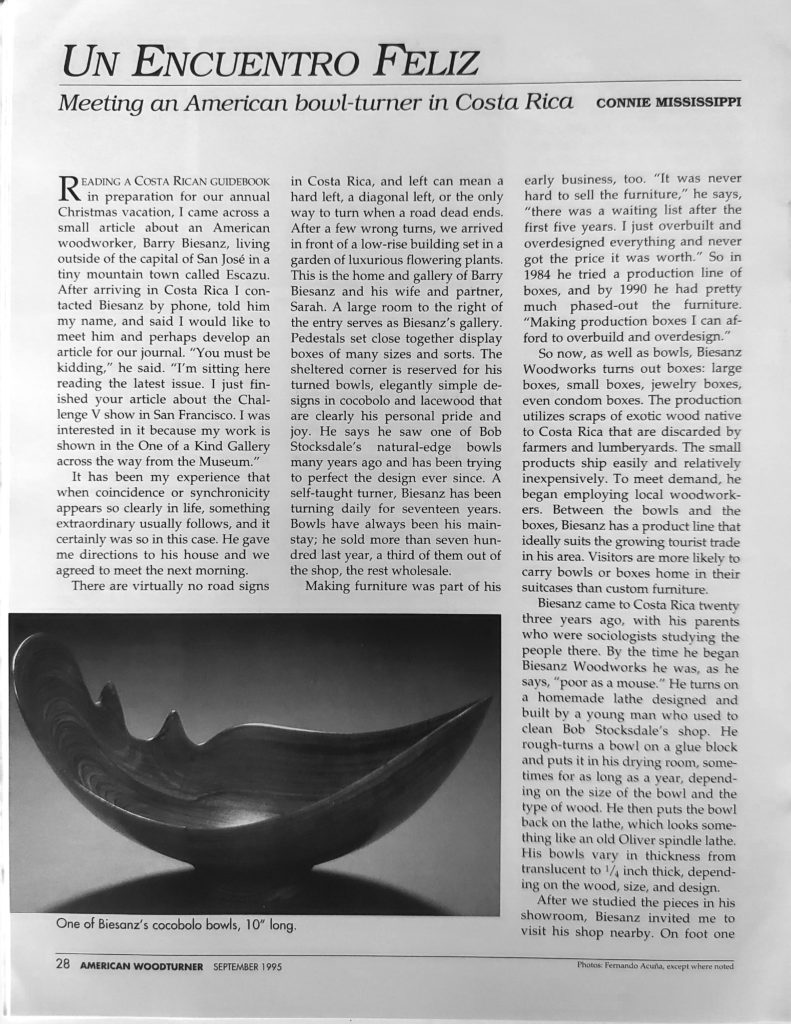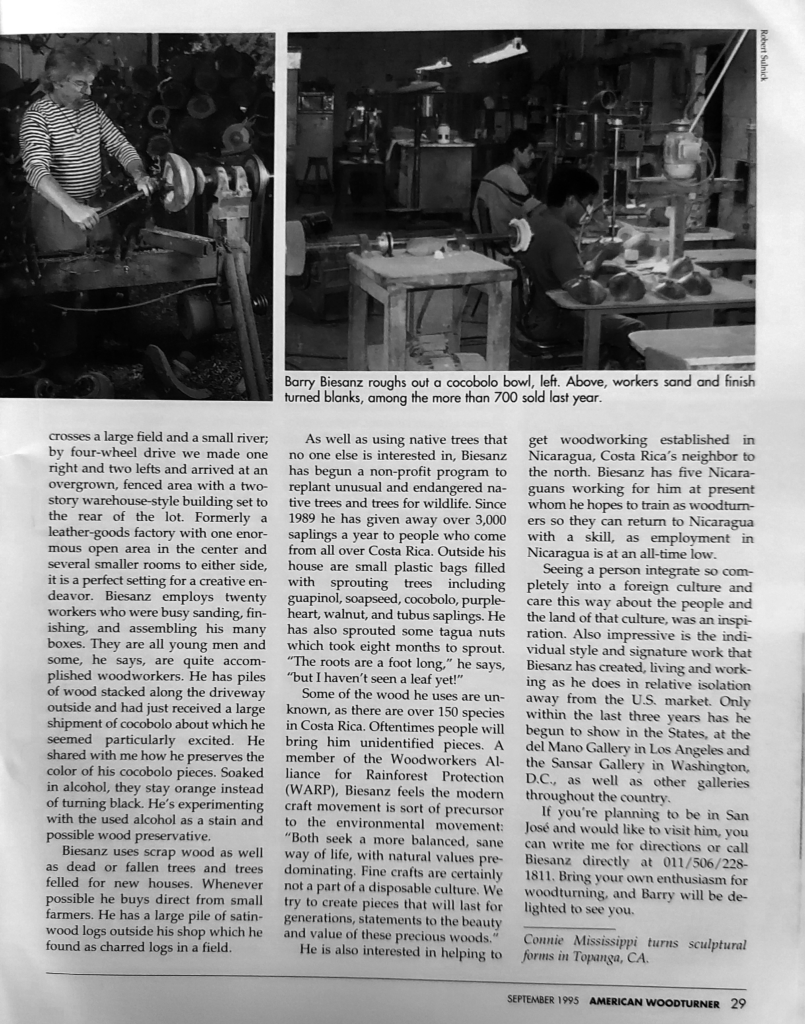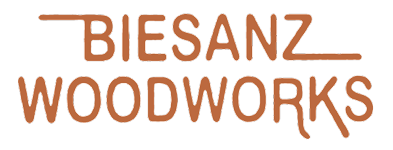American Woodturner - Un Encuentro Feliz 1995



American Woodworker, the Journal of the American Association of Woodturners, 1995 September
Un Encuentro Feliz: Meeting an American Bowl Turner in Costa Rica
Connie Mississippi
Reading a Costa Rican guidebook in preparation for our annual Christmas vacation, I came across a small article about an American woodworker, Barry Biesanz, living outside the capital of San Jose in a tiny mountain town called Escazú. After arriving in Costa Rica I contacted Biesanz by phone, told him my name and said I would like to meet him and perhaps develop an article for our journal. “You must be kidding,” he said. “I’m sitting here reading the latest issue. I just finished your article about the Challenge V show in San Francisco. I was interested in it because my work is shown in the gallery One of a Kind Gallery across the way from the museum. It has been my experience that when coincidence or synchronicity appears so clearly in life, something extraordinary follows, and it certainly was so in this case. He gave me directions to his house and we agreed to meet the next morning.
There are virtually no road signs in Costa Rica, and left can mean a hard left, a diagonal left, or the only way to turn when a road dead ends. After a few wrong turns, we arrived in front of a low-rise building set in a garden of luxurious flowering plants. This is the home and gallery of Barry Biesanz and his wife and partner, Sarah. A large room to the right of the entry serves as Biesanz’ gallery. Pedestals set close together display boxes of many sizes and sorts. The sheltered corner is reserved for his turned bowls, elegantly simple designs in cocobolo and lacewood that are clearly his personal pride and joy. He says he saw one of Bob Stocksdale’s natural-edge bowls many years ago and has been trying to perfect the design ever since.
A self taught turner, Biesanz has been turning daily for seventeen years. Bowls have always been his mainstay; he sold more than seven hundred last year, a third of them out of the shop, the rest wholesale.
Making furniture was part of his early business, too. “It was never hard to sell the furniture,” he says, “there was a waiting list after the first five years. I just overbuilt and over-designed everything and never got the price it was worth.” So in 1984 he tried a production line of boxes, and by 1990 he had pretty much phased-out the furniture. “Making production boxes I can afford to overbuild and over-design.”
So now, as well as bowls, Biesanz Woodworks turnes out boxes: large boxes, small boxes, jewelry boxes, even condom boxes. The production utilizes scraps of exotic wood native. to Costa Rica that are discarded by farmers and lumberyards. The small products ship easily and relatively inexpensively. To meet demand, he began employing local woodworkers. Between the bowls and the boxes, Biesanz has a product line that ideally suits the growing tourist trade in his area. Visitors are more likely to carry bowls or boxes home in their suitcases than custom furniture.
Biesanz came to Costa Rica twenty three years ago, with his parents who were sociologists studying the people there. By the time he becan Biesanz Woodworks he was, as he says, “poor as a mouse.” He turn on a homemade lathe designed and built by a young man who used to clean Bob Stocksdale’s shop. He rough-turns a bowl on a glue block and puts it in his drying room, sometimes for as long as a year, depending on the size of the bowl and the type of wood. He then puts the bowl back on the lathe, which looks something like an old Oliver spindle lathe. His bowls vary in thickness from translucent to ¼ inch thick, depending on the wood, size, and design.
After we studied the pieces in his showroom, Biesanz invited me to visit his shop nearby. On foot one crosses a large field and a small river; by four-wheel drive we made one right and two lefts and arrived at an overgrown, fenced area with a two story warehouse-style building set to the rear of the lot. Formerly a leather-goods factory with one enormous open area in the center and several smaller rooms to either side, it is a perfect setting for a creative endeavor. Biesanz employs twenty workers who were busy sanding, finishing, and assembling his many boxes. They are all young men and some, he says, are quite accomplished woodworkers. He has piles of wood stacked along the driveway outside and had just received a large shipment of cocobolo about which he seemed particularly excited. He shared with me how he preserves the color of his cocobolo pieces. Soaked in alcohol, they stay orange instead of turning black. He’s experimenting with the used alcohol as a stain and possible wood preservative.
Biesanz uses scrap wood as well as dead or fallen trees and trees felled for new houses. Whenever possible he buys direct from small farmers. He has a large pile of satinwood logs outside his shop which he found as charred logs in a field.
As well as using native trees that no one else is interested in, Biesanz has begun a non-profit program to replant unusual and endangered native trees and trees for wildlife. Since 1989 he has given away over 3,000 saplings a year to people who come from all over Costa Rica. Outside his house are small plastic bags filled with sprouting trees including guapinol, soapseed, cocobolo, purpleheart, walnut, and tubus saplings. He has also sprouted some tagua nuts which took eight months to sprout. “The roots are a foot long,” he says, “but I haven’t seen a leaf yet!”
Some of the wood he uses are unknown, as there are over 150 species in Costa Rica. Oftentimes people will bring him unidentified pieces. A member of the Woodworkers Alliance for Rainforest Protection (WARP) Biesanz feels the modern craft movement is sort of a precursor to the environmental movement: “Both seek a more balanced, sane way of life, with natural values predominating. Fine crafts are certainly not a part of a disposable culture. We try to create pieces that will last for generation, statements to the beauty and value of these precious woods.”
He is also interested in helping to get woodworking established in Nicaragua, Costa Rica’s neighbor to the north. Biesanz has five Nicaraguans working for him at present whom he hopes to train as woodturners so they can return to Nicaragua with a skill, as employment in Nicaragua is at an all-time low.
Seeing a person integrate so completely into a foreign culture and care this way about the people and the land of that culture, was an inspiration. Also impressive is the individual style and signature work that Biesanz has created, living and working as he does in relative isolation away from the U.S. market. Only within the last. three years has he begun to show in the States, at the del Mano Gallery in Los Angeles and the Sansar Gallery i Washington, D.C., as well as other galleries throughout the country.
If you’re planning to be in San José and would like to visit him, you can write me for directions or call Biesanz directly at 011 (506) 222-1811. Bring your own enthusiasm for woodturning, and Barry will be delighted to see you.
Connie Mississippi turn sculptural forms in Topanga, CA.
